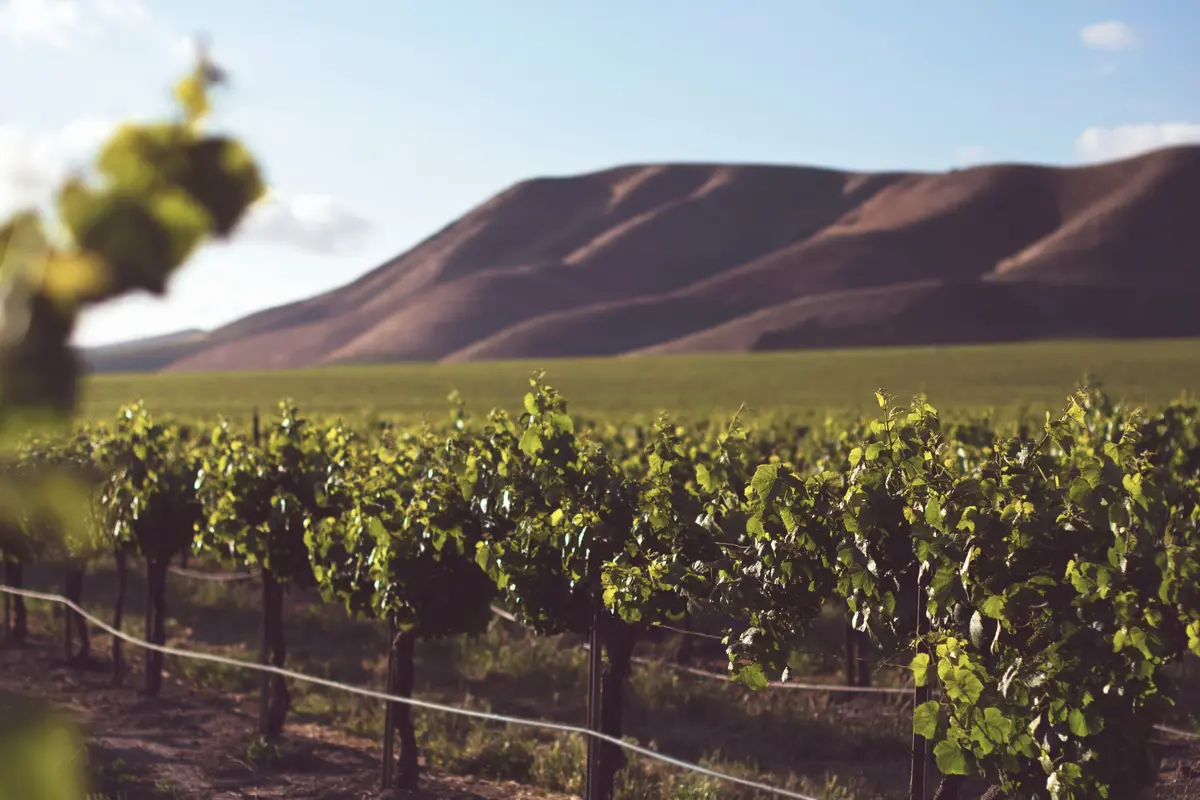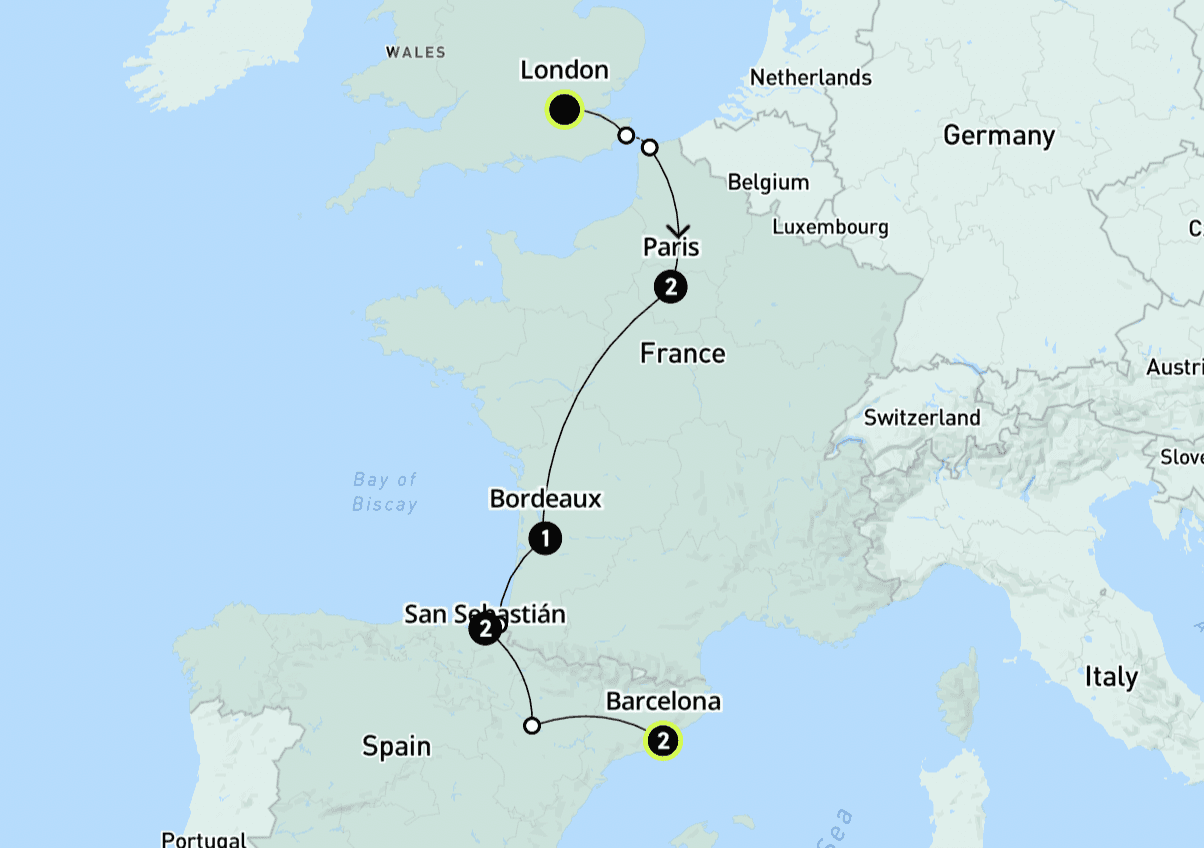Dreaming of sipping Rioja under the Spanish sun or exploring Ribera del Duero’s stunning vineyards? Our 2025 guide to Spain’s wine regions will take you from iconic wineries to hidden gems.
Whether you’re a seasoned wine lover or planning your first wine tour, this guide offers maps, expert tips, and must-visit bodegas to make your trip unforgettable.
Get ready to explore Spain’s wine culture like never before—here’s everything you need to plan your ultimate 2025 wine adventure.
Let’s dive in!

Spain is a wine lover’s paradise, boasting the largest vineyard area in the world and producing some of the finest wines known globally. From bold reds in Rioja to crisp whites in Rías Baixas, Spain’s wine country offers a perfect blend of tradition, history, and breathtaking landscapes.
Spain’s wine regions are divided into Denominación de Origen (DO) classifications—official quality designations similar to France’s AOC or Italy’s DOCG. There are 17 major wine regions, each offering a unique experience for travelers.
Top highlights include:
Rich Wine History: Spain has been producing wine for over 3,000 years, making it a cornerstone of Spanish culture.
Incredible Diversity: From the Atlantic coast’s cool whites to the sun-soaked Mediterranean reds.
Accessible Vineyards: Wine tours are available across iconic regions like Rioja, Ribera del Duero, and Priorat.
Download our Spanish Wine Regions Map to help plan your vineyard adventure. It covers all major DOs, routes, and must-visit wineries.
Top Wine Regions to Visit in Spain in 2025
Spain offers a wealth of wine regions, but these standout destinations are unmissable for 2025:
Rioja – The Heart of Spanish Wine
When you think of Spanish wine, Rioja is often the first name that comes to mind. Famous for its smooth, oak-aged reds primarily made with Tempranillo grapes, Rioja is a must-visit for wine lovers.
Best Experiences:
Tour iconic wineries like Marqués de Riscal with its stunning architecture.
Explore medieval wine cellars in Laguardia, a picturesque village surrounded by vineyards.
Don’t Miss: The Haro Wine Festival in June, where locals celebrate with wine battles and endless tastings.

Ribera del Duero – Bold Reds and Stunning Views
Located along the Duero River, Ribera del Duero produces some of Spain’s boldest and most elegant red wines. Its signature grape, Tempranillo, shines here under the sunny, continental climate.
Best Experiences:
Visit Bodega Protos, an award-winning winery nestled under a medieval castle.
Take a vineyard tour and tasting along the Golden Mile, home to Spain’s most prestigious wineries.
Why Go in 2025: New tasting rooms and boutique vineyard stays are opening, offering elevated experiences.
Priorat – Spain’s Premium Wine Paradise
Tucked away in Catalonia, Priorat is a hidden gem producing some of Spain’s most premium wines. Known for its rugged terrain and Garnacha-based reds, Priorat is a dream for adventurous travelers and serious wine enthusiasts.
Best Experiences:
Hike through the steep vineyards with breathtaking mountain views.
Visit Clos Mogador, one of the pioneering wineries of this premium region.
Insider Tip: Pair Priorat reds with hearty Catalan cuisine for a full sensory experience.
Lesser-Known Spanish Wine Regions Worth Exploring
While Rioja and Ribera del Duero steal the spotlight, Spain’s lesser-known wine regions are just as captivating—offering fewer crowds, unique wines, and an authentic local experience.
Toro – The Hidden Gem for Bold Reds
Located in Zamora, Toro is an up-and-coming region producing powerful, full-bodied reds made from Tinta de Toro (a local clone of Tempranillo).
Why Visit: Toro wines are bold yet affordable, perfect for wine lovers looking for quality without the hefty price tag.
Must-Try Winery: Bodega Numanthia, known for its intense, complex reds.
Rías Baixas – A Paradise for White Wine Lovers
Situated on Spain’s lush Atlantic coast, Rías Baixas is the birthplace of Albariño, one of Spain’s most refreshing white wines. The cool maritime climate lends a crisp, citrusy character to the wines.
Why Visit: Scenic coastal vineyards, fresh seafood, and charming fishing villages.
Don’t Miss: The Albariño Wine Festival in Cambados every August.

Jumilla – Discover Monastrell’s Charm
In the sun-drenched southeast, Jumilla is a rising star for robust, fruit-forward wines made from Monastrell (Mourvèdre).
Why Visit: Jumilla is perfect for discovering affordable, high-quality wines in a laid-back setting.
Must-See: Tour family-run wineries like Casa Castillo, where tradition meets innovation.
Spanish Wine Maps: Navigating Wine Country Like a Pro
Exploring Spain’s diverse wine regions is a breeze when armed with the right maps. Whether you’re planning a self-guided road trip or joining a vineyard tour, a clear Spanish wine map will help you navigate this incredible wine country.
Types of Maps to Use for Your Wine Adventure
Spanish Wine Regions Map: A detailed overview of all 17 Denominación de Origen (DO) regions. Essential for planning which areas to visit based on your wine preferences.
Wineries Map: Focused maps that highlight must-visit bodegas, tasting rooms, and vineyard accommodations. These maps make it easy to design your wine itinerary.
Interactive Maps: Platforms like Google Maps and Wine Routes of Spain offer digital tools to plot wine tours with stops for dining and sightseeing.
Key Wine Routes to Explore
La Ruta del Vino de Rioja: A classic trail that winds through medieval towns and top wineries in Spain’s most famous wine region.
The Ribera del Duero Wine Route: Follow the Duero River and enjoy tastings at prestigious estates, paired with stunning landscapes.
The Cava Trail in Penedés: Perfect for sparkling wine lovers, this route takes you through the heart of Cava production.
Sign up to the newsletter to receive the Paradiso Spain experience by Map.
How to Plan a Spanish Wine Tour for 2025
Planning a Spanish wine tour can be an overwhelming yet exciting experience. Here’s a step-by-step guide to help you make the most of your trip in 2025.
Step 1: Choose the Right Time to Visit
The best seasons to visit Spain’s wine regions are:
Spring (April–June): Warm temperatures, fewer crowds, and blooming vineyards.
Autumn (September–October): The harvest season offers vibrant activity and wine festivals.
Avoid the peak of summer (July–August) if you dislike heat and large crowds.
Step 2: Plan Your Must-Visit Wineries
Each region has standout bodegas that offer unique experiences. Here are a few to add to your itinerary:
Marqués de Riscal (Rioja): A must-visit for its stunning architecture and world-class tastings.
Bodega Vega Sicilia (Ribera del Duero): Iconic and luxurious, this winery is famed for its premium reds.
Codorníu (Penedés): The oldest Cava producer, offering fascinating underground cellar tours.
Bodega Numanthia (Toro): A gem for robust reds in a quiet, scenic setting.
Tip: Many wineries require advance bookings for tours and tastings, so plan early—especially for popular bodegas.

Step 3: Choose Accommodation Close to the Vineyards
Stay in charming vineyard hotels or boutique stays for an immersive experience. Some recommendations include:
Hotel Marqués de Riscal (Rioja): A luxury stay within the winery’s iconic Frank Gehry-designed building.
Abadía Retuerta LeDomaine (Ribera del Duero): A converted monastery offering vineyard views and fine dining.
Rural Boutique Hotels in Priorat: Small, locally-run properties for an authentic experience surrounded by stunning mountain scenery.
Step 4: Transportation Tips
Car Rentals: Renting a car gives you the freedom to explore vineyards at your own pace. Spain’s roads are well-maintained, and signage for wine routes is clear.
Guided Wine Tours: Opt for a guided group or private tour if you prefer a stress-free experience. Companies like Cellar Tours and Spain Wine Tours offer curated itineraries.
Local Transport: Some regions, like Rioja and Penedés, have local buses or trains connecting wineries.
Pro Tip: Hire a driver or join a tour if you plan to indulge in tastings—safety first!
Before you dial, learn how much it really costs to call Spain and the best ways to save.
Must-Try Wines and Tasting Tips
Spain produces an incredible variety of wines, each unique to its region. Whether you’re a seasoned connoisseur or a beginner, here’s a guide to must-try Spanish wines and tips to enhance your tasting experience.
Top Spanish Wines to Try
Tempranillo (Rioja & Ribera del Duero): Spain’s signature grape produces smooth, velvety reds with flavors of red berries, vanilla, and spice.
Garnacha (Priorat): Bold and fruity reds that reflect the rugged terrain of Catalonia.
Albariño (Rías Baixas): A refreshing white wine with crisp acidity and notes of citrus and green apple—perfect for seafood.
Cava (Penedés): Spain’s answer to Champagne, this sparkling wine is made using the traditional method.

Wine Tasting Tips for Beginners
Look: Observe the wine’s color and clarity—reds tend to deepen with age, while whites can become golden.
Swirl: Gently swirl the wine to release its aromas.
Smell: Take a deep sniff to identify notes like fruit, spice, or oak.
Sip: Let the wine coat your palate and notice the balance of flavors.
Pair: Pair wines with local tapas for a full sensory experience.
Insider Tip: In Spain, wine tastings often come with complimentary tapas, making it a true cultural delight!
Food and Wine Pairing: A Spanish Delight
One of the greatest joys of exploring Spain’s wine regions is discovering how beautifully the wines pair with local cuisine. From light tapas to hearty stews, Spanish food enhances the flavors of the wines and completes the experience.
Classic Wine and Food Pairings
Albariño + Seafood: The crisp acidity of Albariño from Rías Baixas is perfect with grilled prawns, clams, or Galician-style octopus (pulpo a la gallega).
Tempranillo + Jamón Ibérico: Rioja’s Tempranillo complements the salty, nutty richness of Spain’s prized cured ham.
Cava + Tapas: Spain’s sparkling wine, Cava, is versatile, pairing well with fried calamari, manchego cheese, and patatas bravas.
Monastrell + Lamb Stew: The bold, earthy reds of Jumilla enhance the flavors of slow-cooked lamb dishes.
Perfect Pairings by Region
Rioja: Pair a smooth Tempranillo with chuletillas al sarmiento—succulent lamb chops grilled over grapevine shoots. The smoky, earthy notes of the dish elevate Rioja’s oak-aged reds.
Priorat: Complement the bold, rich flavors of Garnacha wines with butifarra, a Catalan sausage seasoned with garlic and spices. The pairing highlights Priorat’s rugged terroir and robust wines.
Rías Baixas: Enjoy the refreshing citrus notes of Albariño with a mariscada, a Galician seafood platter featuring crab, mussels, and prawns. This coastal pairing is both fresh and indulgent.
Jerez (Sherry Wines): Dry Fino Sherry pairs wonderfully with salty jamón ibérico or olives, while a sweet Pedro Ximénez shines alongside tarta de Santiago—a traditional almond cake.
Ribera del Duero: The bold reds of Ribera, primarily Tempranillo, are a perfect match for lechazo asado—slow-roasted suckling lamb, a classic dish of Castilla y León.

Spanish Wine Terminology Made Simple
Exploring Spanish wine regions is thrilling, but if you’re unfamiliar with wine lingo, it can feel a bit overwhelming. Here’s a quick guide to essential Spanish wine terms to make your trip smoother:
Crianza: A red wine aged for at least 2 years, with a minimum of 6 months in oak barrels. These wines are fresh and fruit-forward with subtle oak notes.
Reserva: Wines aged for 3 years, with at least 12 months in oak. Expect richer, more complex flavors.
Gran Reserva: The pinnacle of Spanish reds, aged for 5 years, including 18–24 months in oak. Smooth, elegant, and reserved for exceptional vintages.
Bodega: Spanish for "winery" or "wine cellar." You’ll hear this word often when booking vineyard tours.
Vendimia: Refers to the grape harvest season, typically in September and October. Many wineries allow visitors to participate during this time.
Cava: Spain’s celebrated sparkling wine, produced mainly in Catalonia using the traditional Champagne method.
Tempranillo: Spain’s flagship red grape, found in Rioja, Ribera del Duero, and Toro. It’s known for its balance of fruit and oak.
Albariño: A crisp, aromatic white wine grape from Rías Baixas, perfect for seafood lovers.
Why It Matters: Knowing these terms not only enhances your tasting experiences but also allows you to impress your friends with your wine knowledge.
Insider Tips for Foodies
Look for restaurants offering wine-pairing menus or book tastings with tapas at wineries.
Explore local specialties: Pair Priorat’s Garnacha with calcots (grilled spring onions) during Catalonia’s winter festival.
Pro Tip: Spanish meals are meant to be savored slowly. Take your time to enjoy the interplay of flavors between the wine and food.
Spanish Wine Festivals and Events in 2025
Spain’s wine festivals offer an immersive way to experience its vibrant culture. These lively events combine tastings, celebrations, and traditions unique to each region.
Top Wine Festivals to Attend in 2025
Haro Wine Festival (Rioja)
When: June 29, 2025 (Feast of St. Peter).
Highlights: Known as the “Battle of Wine,” locals and visitors douse each other in red wine before enjoying tastings and festivities in the town of Haro.
Albariño Festival (Rías Baixas)
When: August 2025 (first week).
Highlights: A celebration of Albariño wines in Cambados, featuring tastings, food stalls, and live music.
Cava Week (Penedés)
When: October 2025.
Highlights: A week-long event celebrating Spain’s sparkling wine, with guided tours of cava cellars, tastings, and food-pairing events.
Toro Harvest Festival
When: Late September 2025.
Highlights: Celebrate the grape harvest with wine tastings, parades, and traditional music in Toro.
Why Visit These Festivals?
Festivals allow you to meet winemakers and locals who are passionate about their craft.
Whether it’s a wine battle or sampling seafood with Albariño, these events are unforgettable.
Capture festival highlights like wine-soaked crowds or vineyard sunsets to share your adventure.
Beyond the major festivals like the Haro Wine Battle and Albariño Festival, Spain is filled with smaller, authentic celebrations that showcase local traditions.
1. La Batalla del Vino Blanco (The White Wine Battle)
Where: San Asensio, Rioja
When: July 2025
Highlights: Similar to the Haro festival but with white wine, this quirky event is a riot of fun and tradition. Expect wine fights, parades, and local food stalls.
2. Fiesta de la Vendimia in Jerez
Where: Jerez de la Frontera, Andalusia
When: Late September 2025
Highlights: Celebrate the grape harvest season in the birthplace of Sherry wines. Events include traditional grape stomping, flamenco performances, and Sherry tastings in ancient bodegas.

3. Priorat Wine Fair
Where: Falset, Priorat
When: May 2025
Highlights: A laid-back festival showcasing the region’s famous Garnacha and Carignan wines. Meet winemakers, enjoy tastings, and pair wines with Catalan cuisine.
4. Toro Wine Week
Where: Toro, Zamora
When: Early October 2025
Highlights: A celebration of Toro’s bold reds, featuring tours of local wineries, cultural events, and special tastings paired with local meats and cheeses.
Why You Should Go
These smaller festivals offer a more intimate experience and fewer crowds while still immersing you in Spain’s rich wine culture. Plus, they’re perfect opportunities for stunning photos, meeting locals, and discovering new favorite wines.
Before your trip, it's beneficial to learn these useful Spanish phrases to ensure smoother communication during your travels in Spain.
Tips for Photographing Spain’s Wine Regions
Spain’s wine regions are as picturesque as they are delicious. With rolling vineyards, historic wineries, and dramatic backdrops, they’re a dream for photographers. Here’s how to capture them beautifully:
Best Photography Spots
Rioja’s Vineyards at Sunset
The golden light over Rioja’s terraced vineyards and iconic Marqués de Riscal winery creates postcard-perfect images.
Priorat’s Rugged Terrain
Snap the dramatic hillside vineyards with views of ancient villages like Siurana nestled among the cliffs.
Rías Baixas’ Coastal Vineyards
Capture the unique pergola-trained vines against the backdrop of the Atlantic Ocean.

Photography Tips
Timing Is Everything:
Visit vineyards during golden hour (just after sunrise or before sunset) for soft, warm lighting.
Include the Details:
Focus on wine barrels, grape clusters, or a glass of wine with the vineyard in the background for intimate, storytelling shots.
Use a Tripod for Long Shots:
Essential for capturing sweeping landscapes or low-light shots during winery tours.
Incorporate People:
Candid moments of locals harvesting grapes or friends enjoying a wine tasting add life and relatability to your photos.
Pro Tip for Social Media
Use hashtags like #SpainWine2025 or #SpanishVineyards to share your photos and engage with fellow travelers and wine enthusiasts.
Bringing Spanish Wine Home: Tips and Regulations
No trip to Spain’s wine regions is complete without bringing back a few bottles of your favorite wines. Whether as a gift or a personal souvenir, here’s what you need to know about transporting Spanish wine home safely and legally.
Rules for Bringing Wine to the UK
Post-Brexit, travelers can bring wine from Spain to the UK under the following allowances:
Duty-Free Limit: Up to 18 liters of still wine (24 standard bottles) and 9 liters of sparkling wine (12 bottles).
Customs Declaration: If you exceed the duty-free limit, declare your goods at customs and pay the applicable tax.
Packing Tips for Safe Transport
Buy Protective Sleeves: Many wineries sell padded wine sleeves for luggage. Alternatively, use bubble wrap or clothing as padding.
Invest in a Wine Travel Bag: Specialized bags like VinGardeValise protect multiple bottles.
Check Airline Policies: If flying, pack wine in checked luggage and ensure it complies with airline weight limits.
Shipping Services: Some wineries offer international shipping directly to your home. Ask about their export services.
Pro Tip: Label each wine bottle with the region and tasting notes you loved. It makes for a great story when sharing with friends and family.
Plan Your 2025 Wine Adventure Today
Spain’s wine regions promise a perfect blend of culture, scenery, and unforgettable flavors. Whether you’re exploring Rioja’s iconic reds, wandering the rugged landscapes of Priorat, or savoring fresh Albariño on the Galician coast, Spain is a wine lover’s dream.
Your Next Steps
Choose your favorite wine regions to explore—Rioja, Ribera del Duero, Priorat, or hidden gems like Toro and Jumilla.
Book tours at standout bodegas and vineyard hotels for an immersive experience.
Mark your calendar for 2025 wine festivals—the perfect way to celebrate Spain’s wine culture.
Don’t forget to download our Spanish Wine Regions Map to help plan your itinerary!
Ready to plan your unforgettable 2025 wine adventure in Spain?
Sign up for our newsletter to receive the exclusive Paradiso Experience Map, highlighting the best wineries, hidden gems, and must-see spots across Spain’s wine regions!
FAQS Travel to Paradiso
Recent Posts
















